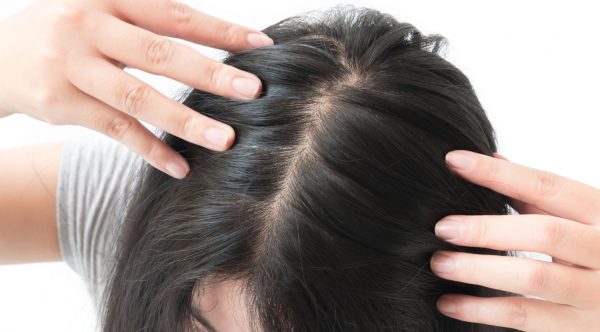Talk to an advisor : +9714 335 3839 Email: Info@viviscal.ae
Talk to an advisor : +9714 335 3839 Email: Info@viviscal.ae
Talk to a Customer Service: +9714 335 3839 Email: Info@viviscal.ae
.png)
What You Need to Know About Telogen Effluvium Hair Loss
It’s normal to shed up to 100 hair strands each day. But if you’re noticing more hair than usual in your brush or shower drain, you may have telogen effluvium. Telogen effluvium happens when a sudden physical trauma “shocks” hair follicles, resulting in increased shedding a few months after the event. According to the American Hair Loss Association, telogen effluvium is the second most common type of hair loss that dermatologists see in women and men. Learn what events or conditions can cause telogen effluvium. See treatment options and what you can do to restore your hair after telogen effluvium hair loss, including clinically proven Viviscal hair growth† supplements.
Telogen effluvium affects the phases of the hair growth cycle. The hair cycle has four phases:
The anagen or “growing” phase, which lasts between 2 and 7 years
The catagen or “regression” phase, which lasts 10 days
The telogen or “resting” phase, which lasts around 3 months
The exogen or “shedding” phase
A healthy human scalp usually has 80-90% of hair follicles in the anagen phase, and just 10-20% in the telogen phase.
In cases of typical telogen effluvium, a stressful external event shocks the body, pushing a significantly higher amount of hair follicles from the anagen phase to the telogen phase. Then, as the hair follicles reach the exogen phase, noticeable shedding occurs.
Telogen effluvium results in overall thinning of the hair, rather than a receding hairline. The thinning may not be uniform. Thus, you could have patches of more significant hair loss. Noticeable hair thinning at the top of the head is a common symptom. People with telogen effluvium never lose all their hair, but the hair thinning can be significant and noticeable.

Triggers of classic telogen effluvium include:
Short periods of intense stress and anxiety
Illness
Physical trauma, such as experiencing a car crash or undergoing surgery
Significant hormonal changes, such as after giving birth
Rapid weight loss, whether through crash dieting or bariatric surgery
Telogen effluvium hair loss doesn’t occur immediately after a traumatic event. Instead, the hair shedding usually becomes noticeable one or two months after the shock. With shorter-term, more temporary triggers, hair follicles usually will resume growth soon after shedding. This type of telogen effluvium hair loss usually lasts around six months. And most people can recover their full hair density about one year after shedding begins.
However, sometimes telogen effluvium can be more persistent. For example, the hair follicles may enter the resting phase at a normal rate, but stay resting longer than usual, delaying entering the growing phase. In this case, the hair slowly will thin.
In another type of telogen effluvium, the hair follicles have shortened growth cycles. As a result, the hair follicles shed short, thin hairs more frequently, and remain in the growing phase for much shorter periods. More persistent cases of telogen effluvium can result from longer-term or more serious physical traumas or events, including:
Chronic illness
Chronic stress
Chronic vitamin deficiencies, such as anemia.
Persistent cases of telogen effluvium can be more difficult to treat, and recovery may take longer. But full recovery is possible.

There are many different factors that can cause hair loss, including medication side effects, chronic hormonal imbalances or other serious conditions. So, the first step in treating telogen effluvium is to confirm with your doctor if in fact you have TE or if there’s another more chronic condition causing your hair thinning. In cases of classic telogen effluvium, your hair usually will begin to regrow 6-12 months after the stressor has ended.
For example, if you’re experiencing hair loss a few months after bariatric surgery, that can be due to a combination of factors. It could be caused by the physical trauma of the surgery, or the sudden reduction in nutrient and calorie levels in your diet following the procedure.
Over time, with nutritional supplements and as your body recovers from surgery, your hair growth should begin to return to normal.
Follow the tips below to make your hair regrowth process as smooth as possible.
Whatever the cause of your telogen effluvium, these tips will help you to grow thicker hair that looks shiny and healthy.
Improve Your Nutrition
Your hair follicles require a healthy balance of nutrients like protein, vitamin C, iron, and zinc in order to grow thicker, stronger hair. So focus on eating a diet filled with lean proteins, healthy fats, and plenty of fruits and vegetables.
Additionally, take Viviscal hair growth† supplements, which contain vitamins and minerals to nourish healthy hair follicles. This will ensure you’re consuming adequate nutrition to support hair growth† after telogen effluvium.*
Take a Break from Styling
Hair dryers, curling irons and straighteners apply heat to the hair shaft. High heat can compromise and damage the hair’s protective cuticle layer. This leads to breakage.
While you’re regrowing your hair after telogen effluvium, protect your existing hair by taking a break from heat styling. Instead, apply a small amount of Viviscal Gorgeous Growth Densifying Elixir to damp hair and allow to air dry. The ingredients in this leave-in treatment make hair look thicker and healthier without damaging heat styling.

Avoid Over Processing
Similarly, processing hair with bleach, dye, relaxer or perms also can damage your existing hair. Embrace your natural color and texture during this regrowth process to help you avoid damage from these processes and to regain full density more quickly.
Have you ever experienced telogen effluvium? Do you have any tips for regrowing hair after telogen effluvium? Let your fellow readers know in the comments.
Source: www.viviscal.com / https://blog.viviscal.com/sudden-telogen-effluvium-hair-loss/
Viviscal Hair Expert
FREE SHIPPING
Free shipping for all UAE ordersSUPPORT 24/7
24x7 customer and billing support30 DAYS RETURN
30 days return policy on products*SECURED ONLINE PAYMENTS
100% Secured payment modes